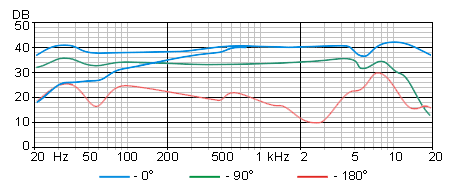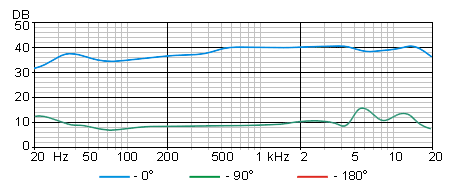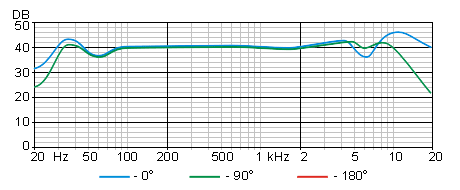 |
|
|
|
||||||||||||||||||||||||||||||||||||||||||||||||||||||||||||||||||||||||||||||
Overview |
|
| Oktava's first twin diaphragm, multi-pattern
microphone - developed from the industry-workhorse Oktava MK-319.
This spectacular new microphone offers all the richness of the special, warm, upfront sound with which the 319 has graced vocal takes all over the world for years - and then some. The new multi-pattern MK-220 offers unprecedented multi-pattern capability in a large diaphragm microphone. In addition to the added ambience-capturing omnidirectional capability, the figure 8 capability - offering balanced pick-up from both sides of the microphone - is perfect to use for more sophisticated stereo miking techniques such as Blumlein and Mid-Side and provides a genuine low-cost/high quality flexibility to your microphone closet. Like the MK-319, it is housed in a casing acoustically designed to reduce sound refractions within the microhpone's grill and to provide good shock resistance and a low self-noise rating - under -18 dB. A maximum SPL of 140 dB (@ 1 kHz) makes the MC-220 great for any number of studio and live voice and instrument recording applications. |
 |
Technical specifications |
|
| Mic type | Large diaphragm condenser |
| Polar Pattern | Cardioid, omni, fig-of-eight |
| Freq. Response, Hz | 20-18000 |
| Output sensitivity, mV/Pa | 10 |
| Max SPL, dB for 0,5% THD | 140 |
| Self Noise (DIN), dBa | <14 |
| Output impedance, ohm | 200 |
| Phase | Positive |
| Powering, V | 48 |
| Supply current, mA | 8 |
| Switches | -10dB / High-Pass Filter |
| Weight, g | 620 |
| Length, mm | 205 |
| Max diameter/width, mm | 52 |
| Temp. Range | -35degrees C to +45 degrees C |
| Relative Humidity | 85% (+25 degrees C) |
| Accessories included | Mic holder |
| Accessories optional | Shock mount |
Frequency response charts |
|
|
EXHardwareOktava Studio MicrophonesTerry Kok |
|
The Oktava microphones come in their own padded plastic cases with a manual and our MK-319 and MK-012 came with their own shockmounts which suspend the microphones to minimize mechanical vibrations. The first mic we're going to take a look at is the MK-319 condenser microphone. The MK-319 is the successor to the MK219 and comes housed in a new casing which has been acoustically designed to cut down the sound refractions inside the grill, allowing a smoother and more open sound, as well as being more rugged and shock resistant. The MK-319 as with all condenser microphones, require phantom powering (48V) and comes with a cardiod (heart shaped) polar pattern. The MK-319 isn't a full range mic but it comes pretty close with a frequency response of 40Hz to 16kHz but according to Oktava, the frequency response extends well beyond that figure. The heart of the mic comes in the form of a 1" gold spattered teflon diaphragm with a low noise discreet preamplifier circuitry. The MK-319 has two switches which provide -10db padding as well as a low frequency cut off. The switches felt a little loose for our taste but they did work without a problem throughout the review. MK-319 In Use The Oktava MK-319 was perhaps our favorite microphone of the bunch. The MK-319, even when compared to the Neumann U87 (which costs many times more) shared a very similar sound character that I found inviting in vocals. Clear, detailed and warm. Although the Neumann mic did rival the MK-319 in the absolute last bit of detail, you should bear in mind that the Neumann mic costs about 8 to 10 times more than the MK-319! The MK-319 had a full bodied and warm, slightly tube-like mid range which can capture one's vocals very well. The only gripe I have about the MK-319 is in the high frequencies, which is present but lacks a bit of magical sparkle at the end. Aside from vocals, I found the MK-319 to be an excellent mic when used in conjunction with the MK-012 for miking our Marshall and Mesa/Boogie Triple Rectifier electric guitar amplifiers. I setup the MK-012 one feet away from the first 12" driver in the speaker cabinet at an angle and the MK-319 4' back in a rather lively room and I managed to pick up some really nice room ambience with both the MK-319 and MK-012 mics. Both held up to really high SPL levels and I only got them to distort when the neighbours were hammering on my wall. I did a couple of guitar tracks with the MK-319 one feet away, aimed at the neck joint at the 12th fret from my Seagull acoustic guitar and the results were really good! Each note came out clear and since the mic was quite close to the guitar, it managed to capture the body resonance of the guitar as well adding an excellent warmth to the overall sound. All in all, the MK-319 makes an excellent vocal and acoustic instrument microphone and it offers a taste of high-end microphones at such an unbeatable value. Conclusion The three Oktava microphones (MK-319,
MK-012 and ML-52) reviewed are amazing performers for the price.
First up, we have the MK-319 which is magical with vocals and
stringed/acoustic instruments. Then comes the MK-012 which is
another amazing performer that is so flexible, it's like having a
whole bunch of mics cramped into one compact design. Get a stereo
matched set and have them setup as drum set overheads! Last but not
least, the ribbon based ML52 proves yet again that ribbon mics
should not be forgotten offering an inviting and warm sound. If
you're looking for great microphones that offer an amazing value for
your money, I would not hesitate to suggest that you give the Oktava
line an audition. Highly recommended! |
User comments |
|
Habe MK-220 mit Stimme und Gitarre eingesetzt. Im Moment mein Lieblingsmikro für den Gesang – es gibt der Stimme einen ganz eigenen Charakter – sehr vintage – aber keineswegs dumpf. Alle Frequenzen sind da – aber im Gegensatz zum MK-102 verhält es sich nicht so neutral sondern betont etwas mehr die oberen Mitten und Höhen. Das Mikro der Wahl für Akustikgitarre! Im Gegensatz zu den MK-012, die ich früher benutzt habe (was innerhalb einer komplexen Produktion aber optimal gepasst hat) bringt es den vollen Umfang der Gitarre auf Band und das ohne das typische Akustikgitarren Wummern zu übertragen. Ich bin höchst überrascht, wie gut dieses Mikrofon dieses “Probleminstrument” an das Ohr des Hörers bringen – Spitze! Auch hier – viel Output – Rauschen fällt weg. Sascha Schuppert-Raetzer |
|
|



